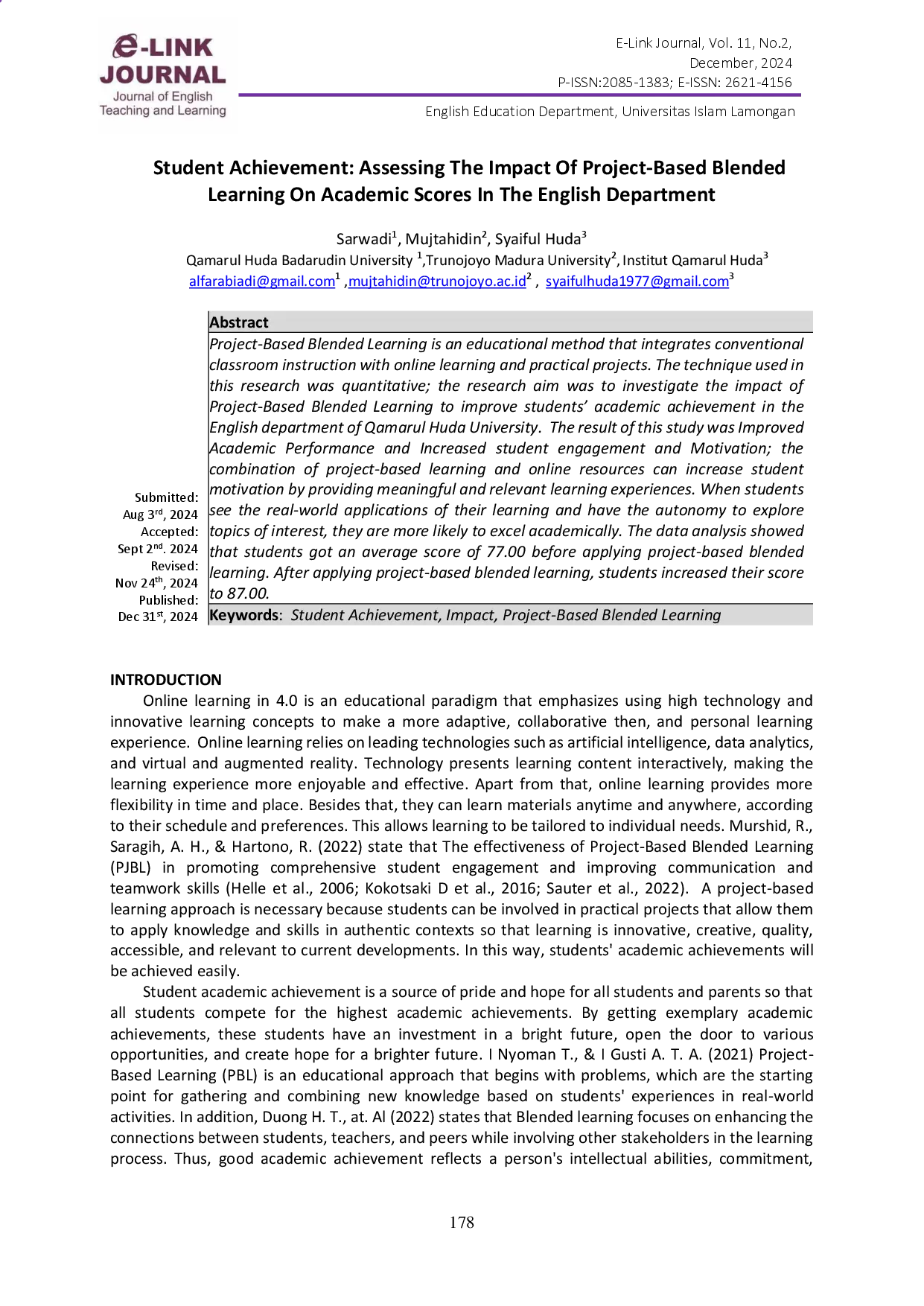UNISLAUNISLA
E-LINK JOURNALE-LINK JOURNALWith the vast applications that can be used for language learning, there are many research concerns about using artificial intelligence in language classrooms. This research aims to explore students attitudes toward the use of Speechace in speaking activities. This research uses qualitative research methods with research instruments such as observation, questionnaire, and interview. Students attitudes can be explored deeply through comprehensive observation and questionnaires in the classroom activity, such as how students respond to teacher elicitation by using chat boot. In addition, to confirm the findings from observation, students thought that they needed to dig through interviews. The subject of the study was 20 students of 8th-grade MTS Alif Lam minim Surabaya through purposive sampling from the teachers suggestion by considering students abilities. The research revealed that students have a positive attitude toward the Speechace in speaking activity. Some reasons underlie this attitude include content, features, and feasibility. In terms of content, students assume that the contents of Speechace are relevant to their context either in school or at home. In addition, speech is varied in features such as speaking, writing, listening, or even writing. Last but not least, Speechace is user-friendly, so students can easily access features and contents even on their first visit to the application. Thus, students enjoy and continuously use speechace in speaking class activities.
The research revealed that students have a positive attitude toward Speechace in speaking activities, attributing this to its relevant content, diverse features, and user-friendly interface.Students found the application engaging, motivating, and fun, leading to increased comfort and confidence in practicing their speaking skills.Despite a minor concern regarding data connection requirements, the study concludes that Speechace is a valuable tool for enhancing English language learning, particularly in speaking classes.
Penelitian lebih lanjut dapat dilakukan untuk menginvestigasi efektivitas Speechace dalam meningkatkan akurasi pengucapan siswa, dengan fokus pada identifikasi kesalahan pengucapan yang paling umum dan bagaimana aplikasi ini membantu memperbaikinya. Selain itu, studi komparatif dapat dilakukan untuk membandingkan efektivitas Speechace dengan metode pembelajaran berbicara tradisional atau aplikasi AI lainnya, untuk menentukan pendekatan mana yang paling optimal bagi siswa dengan berbagai tingkat kemampuan bahasa Inggris. Terakhir, penelitian kualitatif mendalam dapat dilakukan untuk mengeksplorasi pengalaman siswa menggunakan Speechace di luar kelas, termasuk bagaimana mereka mengintegrasikan aplikasi ini ke dalam rutinitas belajar mandiri mereka dan dampak jangka panjangnya terhadap motivasi dan kepercayaan diri mereka dalam berbicara bahasa Inggris. Penelitian-penelitian ini akan memberikan wawasan yang lebih komprehensif tentang potensi Speechace sebagai alat pembelajaran bahasa Inggris yang efektif dan inovatif, serta membantu guru dan pengembang aplikasi untuk terus meningkatkan kualitas dan relevansinya bagi siswa.
| File size | 495.01 KB |
| Pages | 10 |
| DMCA | ReportReport |
Related /
UNISLAUNISLA In addition, the conclusion of this research was that primarily students experienced trait-like and situational CA, and the factors students experiencingIn addition, the conclusion of this research was that primarily students experienced trait-like and situational CA, and the factors students experiencing
UNISLAUNISLA Metode kualitatif digunakan, dengan data dari 20 mahasiswa semester enam (tahun akademik 2023/2024) yang dikumpulkan melalui observasi, wawancara, survei,Metode kualitatif digunakan, dengan data dari 20 mahasiswa semester enam (tahun akademik 2023/2024) yang dikumpulkan melalui observasi, wawancara, survei,
UNISLAUNISLA Sampel terdiri dari 150 siswa yang mengisi survei. Hasil penelitian menunjukkan bahwa 80% responden memberikan umpan balik positif di semua tema. SiswaSampel terdiri dari 150 siswa yang mengisi survei. Hasil penelitian menunjukkan bahwa 80% responden memberikan umpan balik positif di semua tema. Siswa
UNISLAUNISLA These difficulties stem from a lack of proficiency in text production skills, insufficient knowledge of the descriptive text subject matter, and a lackThese difficulties stem from a lack of proficiency in text production skills, insufficient knowledge of the descriptive text subject matter, and a lack
Useful /
UNISLAUNISLA Penelitian ini bertujuan untuk menganalisis metode pembelajaran ESP yang diterapkan oleh dosen di Universitas Hafsawaty Zainul Hasan. Hasil penelitianPenelitian ini bertujuan untuk menganalisis metode pembelajaran ESP yang diterapkan oleh dosen di Universitas Hafsawaty Zainul Hasan. Hasil penelitian
UNISLAUNISLA Pembelajaran Berbasis Proyek Terpadu adalah metode pendidikan yang mengintegrasikan pembelajaran kelas konvensional dengan pembelajaran online dan proyekPembelajaran Berbasis Proyek Terpadu adalah metode pendidikan yang mengintegrasikan pembelajaran kelas konvensional dengan pembelajaran online dan proyek
UNISLAUNISLA Penelitian menunjukkan bahwa metode ECOLA mendapat penerimaan yang umumnya positif di kalangan siswa kelas X akuntansi, terbukti dari motivasi dan antusiasmePenelitian menunjukkan bahwa metode ECOLA mendapat penerimaan yang umumnya positif di kalangan siswa kelas X akuntansi, terbukti dari motivasi dan antusiasme
UMMUMM Konsep yang dikembangkan menekankan kerja sama internasional dan saling membantu, serta mengusulkan kerangka kerja untuk kolaborasi antara negara majuKonsep yang dikembangkan menekankan kerja sama internasional dan saling membantu, serta mengusulkan kerangka kerja untuk kolaborasi antara negara maju







